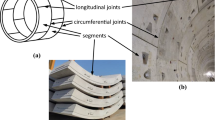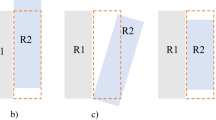Abstract
Thanks to the high safety level and the high-speed rate of work, mechanized tunneling (especially TBM) has speedily spread worldwide for tunnels excavation. Lining behind TBM normally consists of precast rings each one consists of a number of segments connected together with radial and longitudinal bolts. The main items which control the stability of TBM excavation are face pressure, grout pressure and interaction of lining components with grout and surrounding soil.
Many methods have been used to study the behavior of segmental lining including empirical methods, analytical methods, and numerical modelling. The third method is currently considered one of the most commonly used methods for design check purposes. Most tunnelling codes use analytical methods to study the behavior of segmental lining. The aim of this paper is to study the shortenings of current used numerical models and try to improve it, in addition, to check the efficiency of numerical modelling compared to analytical methods. Firstly a comprehensive study will be performed to get an appropriate model for simulating segmental lining components. Consequently, a better understanding will be possible for the interaction between different segmental lining components and the annular grout. The results of the analysis will be discussed and compared to the traditional models to check the efficiency and validity of the numerical modelling technique. Finally, a study will be introduced to investigate the optimum number of bolts may be used between successive segments. This could help in optimizing the segmental lining for less cost and more safety levels.
Access this chapter
Tax calculation will be finalised at checkout
Purchases are for personal use only
Similar content being viewed by others
References
Abu-Krisha, A.A.: Numerical modelling of TBM tunnelling in consolidated clay, Ph.D. thesis, Chapter 7, Innsbruck University, Austria (1998)
Bakker, K.J.: Structural design of lining for bored tunnels in soft ground, Heron J. 48(1) ISSN 0046-7316 (2003)
Blom, C.B.M.: The structural (un)safety of tunnels explained by analytical approach. Heron 48(1), 17–32 (2003). Delft University of Technology
Duddeck, H., Erdmann, J.: Structural design models for tunnels, Scribd website 2012, Universitat Braunschweig, Germany (1982, 2012)
FHWA (2009), U.S. Department of transportation – Federal Highway administration (U.S.A), Technical manual for design and construction of road tunnels, Civil Elements, Publication No. FHWA-NHI-10-034 (2009)
Gruebl, F.: Modern design aspects of segmental lining, International Seminar on Tunnels and Ground Works. LNEC, Lisbon, 29–30 June (2006)
Gruebl, F.: Segmental ring design (New challenges with high tunnel diameters), World Tunnel Congress 2012, Bangkok, Thailand, Tunnelling and Underground Space for a Global Society (2012)
Hu, X., et al.: An analytical method for internal forces in DOT shield-driven tunnel. Tunn. Undergr. Space Technol. 24(6), 675–688 (2009)
Hinchberger, S.D., Ahn, T., Lo, K.Y.: Investigation of segmental concrete tunnel liner joint stiffness. In: World Tunnel Congress and 36th General Assembly, Vancouver, Canada, ITA-AITES, 17 and 19 May (2010)
ITA: WG2 on General Approaches to the Design of Tunnels, Guidelines for the design of tunnels second report, International Tunnelling Association, Working Group No. 2, Research (1988)
ITA: WG2 on General Approaches to the Design of Tunnels, Guidelines for the design of shield tunnel lining, International Tunnelling Association, Working Group No. 2, Research (2000)
JSCE (2007), Japanese standard for shield tunnelling, Japan Society of Civil Engineers, 4 edn., Tokyo (2000). (English translation)
Koyama, Y.: Study on the improvement of design method of segments for shield-driven tunnels (in Japan), RTRI Report: Special No. 33. RTRI, p. 114 (2000)
Koyama, Y.: Present status and technology of shield tunneling method in Japan. Tunn. Undergr. Space Technol. 18(2–3), 145–159 (2003)
Lee, K.M., et al.: An analytical solution for a jointed shield-driven tunnel lining. Int. J. Numer. Anal. Methods Geomech. 25, 365–390 (2001)
Mahajan, R.: 3 dimensional structural modelling of segmental tunnel lining, Aust. Tunn. Soc. (ATS) J. (2010)
MIDAS: MIDAS GTS NX V3.0.0 (4), MIDAS GTS Manual, MIDAS Information Technology Co. Ltd., Gyeonggido, 463–400, Korea
NAT: National Authority for Tunnels. Greater Cairo Metro Line III, Project Documents, Cairo (2009)
Wood, A.M.: Tunneling: management by design, London and New York, 2000, Edition 2002 (2002)
Acknowledgments
Authors would like to sincerely thank Dr. Ashraf Abu-krisha, the head of the technical department at National Authority for Tunnels (NAT), for his great help to provide the available field and technical data. Authors also would like to thank Dr. Ahmed Hassan (Assoc. Prof., Civil Engineering Department at Faculty of Engineering - Minia University), for his valuable comments.
Author information
Authors and Affiliations
Editor information
Editors and Affiliations
Rights and permissions
Copyright information
© 2018 Springer International Publishing AG
About this paper
Cite this paper
Elrehim, M.Z.A., Asaad, M. (2018). Computational and Numerical Considerations of Segmental Lining Design. In: Agaiby, S., Grasso, P. (eds) Engineering Challenges for Sustainable Underground Use. GeoMEast 2017. Sustainable Civil Infrastructures. Springer, Cham. https://doi.org/10.1007/978-3-319-61636-0_3
Download citation
DOI: https://doi.org/10.1007/978-3-319-61636-0_3
Published:
Publisher Name: Springer, Cham
Print ISBN: 978-3-319-61635-3
Online ISBN: 978-3-319-61636-0
eBook Packages: Earth and Environmental ScienceEarth and Environmental Science (R0)




